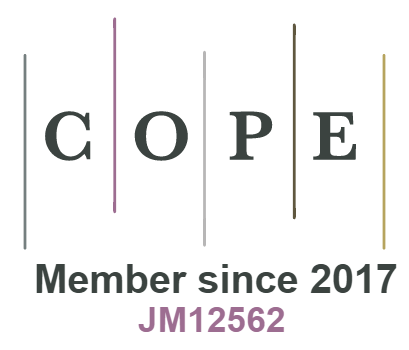Review on Emission of Radiated Electromagnetic Fields from Train Pantograph Arcing
DOI:
https://doi.org/10.18034/ei.v6i1.171Keywords:
Pantograph, Electromagnetic field, Arcing, Electric TrainAbstract
Pantograph arc is one of the most common and yet unavoidable difficulties in electrified railways. During winter the intensity of arcing increases due to ice layer on the overhead catenary wire. In AC traction system, the sinusoidal waveforms of the supply voltage and current distort due to pantograph arcing. It generates both conducted and radiated emission in a wide band. Both the DC component and higher order conducted and radiated emission increases with line speed. The amplitude of the DC voltage shows a wide variation concerning train speed, applied voltage, type of electrical load, the gap between the contact wire and the pantograph and current. In this paper, pantograph arcing and its effects on the railway vehicles are described. Sliding contact between the pantograph contact strips and the catenary contact wire is illustrated with the emphasis on the pantograph arcing. Arc characteristics, formation methods, extinction and resignation of the arc are studied. This paper presents a comprehensive review on pantograph arcing and its effects near radio-based mobile communications and other signaling instruments and some other related areas.
Downloads
References
A. Collina, A. Facchinetti, F. Fossati, and F. Resta, “An application of active control to the collector of an high-speed pantograph: Simulation and laboratory tests,” in Proceedings of the 44th IEEE Conference on Decision and Control, 2005 and 2005 European Control Conference. CDC-ECC, Seville, Spain, Dec. 2005, pp. 4602–4609.
A. J. Mauriello and J. M. Clarke, “Measurement and analysis of radiated electromagnetic emissions from rail-transit vehicles,” IEEE Trans. Electromagn. Compat., vol. 25, no. 4, pp. 405–411, Nov. 1983.
Angelstam, P., et al., Learning about the history of landscape use for the future: Consequences for ecological and social systems in Swedish Bergslagen. Ambio, 2013. 42(2): p. 146-159.
B. Tellini, M. Macucci, R. Giannetti, and G. A. Antonacci, “Conducted and radiated interference measurements in the line-pantograph system,” IEEE Trans. Instrum. Meas., vol. 50, no. 6, pp. 1661–1664, Dec. 2001.
Balestrino, A., Bruno, O., Landi, A. and Sani L. Innovative solutions for overhead catenary pantograph system: wire actuated control and observed contact force. Veh. Syst. Dynamics Int. J., 2000, 33(2), 69–89.
Barmada, Sami, et al. "Clustering techniques applied to a high-speed train pantograph–catenary subsystem for electric arc detection and classification." Proceedings of the Institution of Mechanical Engineers, Part F: Journal of Rail and Rapid Transit 230.1 (2016): 85-96.
Beadle, A. R., Betts, A. I. and Smith, W. R. Pantograph development for high speed. R. Engrs J., 1975, 72–81.
Bormann, D., Origin of DC component in railway line current upon operation with iced-over overhead line: Theory, experimental results and conclusions. ABB Internal Rep. Project: Investigation of DC Current because of Ice On Contact wire”, Ref. No: SECRC/PT/TR-2003/038, 2003.
Bormann, Dierk, Surajit Midya, and Rajeev Thottappillil. "DC components in pantograph arcing: Mechanisms and influence of various parameters." Electromagnetic Compatibility, 2007. EMC Zurich 2007. 18th International Zurich Symposium on. IEEE, 2007.
Buhrkall, L., DC components due to ice on the overhead contact wire of AC electrified railways. ELEKTRISCHE BAHNEN-CHARLOTTENBURG THEN BERLIN THEN MUNCHEN-, 2005. 103(8): p. 380.
Chen Song , ShaFei, “Three types of electromagnetic noise between pantograph and catenary,” Microwave, Antenna, Propagation and EMC Technologies for Wireless Communications, 2009 3rd IEEE International Symposium on27-29 Oct. 2009, Beijing, China, PP.40 – 43.
D. Bormann, “Origin of DC component in railway line current upon operation with iced-over overhead line: Theory, experimental results and conclusions,” ABB Internal Report of the project: Investigation of DC Current because of Ice on Contact wire, Ref. No: SECRC/PT/TR- 2003/038, May 2003.
D. Bormann, S. Midya, and R. Thottappillil, “DC components in pantograph arcing: Mechanisms and influence of various parameters,” in Proceedings of 18th International Zurich Symposium on Electromagnetic Compatibility, Munich, Germany, Oct. 2007, pp. 369–372.
E. I. Shobert, “Carbon, graphite and contacts,” IEEE Trans. Parts, Hybrids, Packag., vol. PHP-12, no. 6, pp. 62–74, Mar. 1976.
Eppinger, S. D., O’Connor, D. N., Seering, W. P. and Wormley, D. N. Modeling and experimental evaluation of asymmetric pantograph dynamics. Trans. ASME, J. Dynamics Syst., Measmt Control, 1988, 110, 168–174.
Galeotti, G., Galanti, M., Magrini, S. and Toni, P. Servo actuated railway pantograph for high-speed running with constant contact force. Proc. Instn Mech. Engrs, Part F, Journal of Rail and Rapid Transit, 1993, 207(F1), 37–49.
https://mbellek.blogspot.com/2011/01/ac-lokomotif-diyagram.html
https://www.railwaypro.com/wp/pantograph-catenary-interaction-framework-for-intelligent-control/
J. Allan, W. Chan, Z. Shaoz, and B. Mellitt, “Low frequency and radio frequency electromagnetic compatibility for rapid transit railways,” in Proceedings of the 5th European Conference on Power Electronics and Applications, Brighton, UK, Sep. 1993, pp. 106–111.
L. Buhrkall, “DC components due to ice on the overhead contact wire of ac electrified railways,” Electrische Bahnen, vol. 103, no. 8, pp. 380–389, Aug. 2005.
Midya, S. and R. Thottappillil, An overview of electromagnetic compatibility challenges in European Rail Traffic Management System. Transportation Research Part C: Emerging Technologies, 2008. 16(5): p. 515-534.
Midya, Surajit, et al. "Conducted and radiated emission from pantograph arcing in AC traction system." Power & Energy Society General Meeting, 2009. PES'09. IEEE. IEEE, 2009.
P. Pozzobon, A. Amendolara, B. Vittorini, U. Henning, R. Schmid, S. Shirran, and S. Ahlstedt, “Electromagnetic compatibility of advanced rail transport signalling,” in Proceedings of the World Congress on Railway Research (WCRR), Edinburgh, UK, Oct. 2003, pp. 1250–1263.
QIAN Zhongliang, SHENG Wei, ZHANG Zhimiao, et al. “Development of Carbon Contact Strips and Research Progress in China” [J]. Electric Drive for Locomotives, 2003 (Supplement), pp. 5-8
R. Giannetti, M. Macucci, and B. Tellini, “EMI measurements in line pantograph contact discontinuity in railway transportation systems,” in Proceedings of the 11th International Sysmposium on Trends in Electrical Measurement and Instrumentation, IMEKO TC-4, Lisbon, Portugal, Sep. 2001, pp. 25–90.
S. Brillante, P. Ferrari, and P. Pozzobon, “Modelling of electromagnetic emission from catenary-pantograph pliding contact,” in Proceedings of the International Conference on Computer Aided Design, Manufacture and Operation in The Railway and Other Advanced Mass Transit Systems, Lisbon, Portugal, Sep. 1998, pp. 881–890.
S. Midya and R. Thottappillil, “An overview of electromagnetic compatibility challenges in European rail traffic management system,” Transportation Research Part C: Emerging Technologies, 2007, article in press.
S. Midya, “Electromagnetic interference in modern electrified railway systems with emphasis on pantograph arcing,” Licentiate Thesis, Uppsala University, May 2008.
T. Konefal, D. A. J. Pearce, C. A. Marshman, and L. M. McCormack, “Potential electromagnetic interference to radio services from railways,” Final Report, Mar. 2002.
TB/T2809-2005: Copper and Copper-Alloy Contact Wires for Electric Railway [S]. Ministry of Railways of the People's Republic of China, 2005.
--0--
Published
Issue
Section
License
Engineering International is an Open Access journal. Authors who publish with this journal agree to the following terms:
- Authors retain copyright and grant the journal the right of first publication with the work simultaneously licensed under a CC BY-NC 4.0 International License that allows others to share the work with an acknowledgment of the work's authorship and initial publication in this journal.
- Authors are able to enter into separate, additional contractual arrangements for the non-exclusive distribution of the journal's published version of their work (e.g., post it to an institutional repository or publish it in a book), with an acknowledgment of its initial publication in this journal. We require authors to inform us of any instances of re-publication.









